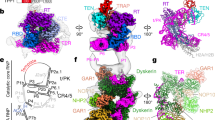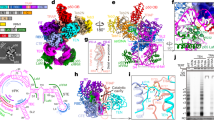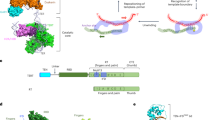Abstract
We report the inhibition of human telomerase activity by peptide nucleic acids (PNAs). PNAs recognize the RNA component of human telomerase (hTR) and inhibit activity of the enzyme with IC50 values in the picomolar to nanomolar range. Inhibition depends on targeting exact functional boundaries of the hTR template and is 10- to 50-fold more efficient than inhibition by analogous phosphorothioate (PS) oligomers. In contrast to high selectivity of inhibition by PNAs, PS oligomers inhibit telomerase in a non-sequence-selective fashion. These results demonstrate that PNAs can control the enzymatic activity of ribonucleoproteins and possess important advantages relative to PS oligomers in both the affinity and the specificity of their recognition. These observations should facilitate the development of effective inhibitors of telomerase activity and affinity probes of telomerase structure.
This is a preview of subscription content, access via your institution
Access options
Subscribe to this journal
Receive 12 print issues and online access
$209.00 per year
only $17.42 per issue
Buy this article
- Purchase on Springer Link
- Instant access to full article PDF
Prices may be subject to local taxes which are calculated during checkout
Similar content being viewed by others
References
Blackburn, E.H. 1991. Telomeres. Trends Biol. Sci. 16: 378–381.
Greider, C.W. 1994. Mammalian telomere dynamics: healing, fragmentation shortening, and stabilization. Curr. Op. Genet, and Dev. 4: 203–211.
Allsopp, R.C. et al. 1995. Telomere shortening is associated with cell division in vitro and in vivo. Exp. Cell Res. 220: 194–200.
Levy, M., Allsopp, R.C., Futcher, A.B., Greider, C.W. and Harley, C.B. 1992. Telomere end-replication problem and cell aging. J. Mol. Biol. 225: 951–960.
de Lange, T. et al. 1990. Structure and variability of human chromosome ends. Cell Biol. 10: 518–526.
Harley, C.B., Futcherm, A.B. and Greider, C.W. 1990. Telomeres shorten during aging of human fibroblasts. Nature 345: 458–460.
Lingner, J., Cooper, J.R. and Cech, T.R. 1995. Telomerase and DMA end replication: no longer a lagging strand problem? Science 269: 1533–1524.
Blackburn, E.H. 1992. Telomerases. Ann. Rev. Biochem. 61: 113–129.
Hanish, J.R., Yanowitz, J.L. and de Lange, T. 1994. Stringent requirements for the formation of human telomeres. Proc. Natl. Acad. Sci. USA 91: 8861–8865.
Kim, N.W. et al. 1994. Specific association of human telomerase activity with immortal cells and cancer. Science 266: 2011–2015.
Bachetti, S. and Counter, C.M. 1995. Telomeres and telomerase in human cancer. Int. J. Oncol. 7: 423–432.
Shay, J.W. 1995. Aging and cancer: are telomerases and telomerase the connection. Mol. Med. Today 1: 378–384.
Shay, J.W. and Wright, W.E. 1996. Telomerase activity in human cancer. Curr. Opin. Oncol. 8: 66–71.
Harley, C.B. et al. 1994. Cell immortality, telomerase and cancer. Cold Spring Harbor Symposia on Quantitative Biology 59: 307–315.
Hiyama, K., Hiyama, K., Yokoyama, T., Matsuura, Y., Piatyszek, M.A., and Shay, J.W. 1995. Correlation telomerase activity levels with human neuroblastoma outcomes. Nature Med. 1: 249–255.
Broccoli, D., Young, J.W. and de Lange, T. 1995. Telomerase activity in normal and malignant hematopoietic cells. Proc. Natl. Acad. Sci. USA 92: 9082–9086.
Bryan, T.M., Engelzou, A., Gupta, J., Bachetti, S. and Reddel, R.R. 1995. Telomere elongation in immortal human cells without detectable telomerase activity. EMBO J. 14: 4240.
Feng, J. et al. 1995. The RNA component of human telomerase. Science 269: 1236–1239.
Collins, K., Kobayashi, R. and Greider, C.W. 1995. Purification of tetrahymena telomerase and cloning of genes encoding the two protein components of the enzyme. Cell 81: 677–686.
Shippen-Lentz, D. and Blackburn, E.H. 1990. Functional evidence for an RNA template in telomerase. Science 247: 546.
Hanvey, J.C. et al. 1992. Antisense and antigene properties of peptide nucleic acids. Science 258: 1481–1485.
Nielsen, P.E., Egholm, M., Berg, R.H., and Buchardt, O. 1991. Sequence-selective recognition of DMA by strand displacement with a thymine-substituted polyamide. Science 254: 1497–1500.
Egholm, M. et al. 1993. PNA hybridizes to complementary oligonucleotides obeying the Watson-Crick hydrogen bonding rules. Nature 365: 566–568.
Demidov, V. et al. 1994. Stability of peptide nucleic acids in human serum and cellular extracts. Biochem. Pharmacol. 48: 1310–1313.
Piatyszek, M.A. et al 1995. Detection of telomerase activity in human cells and tumors by a telomeric repeat amplification protocol. Methods in Cell Science 17: 1–15.
Wright, W.E., Shay, J.W. and Piatyszek, M.A. 1995. Modifications of a telomeric repeat amplification protocol (TRAP) result in increased reliability, linearity, and sensitivity. Nucl. Acids Res. 23: 3794–3795.
Morin, G.B. 1991. Recognition of a chromosome truncation site associated with α-thalassaemia by human telomerase. Nature 353: 454–456.
Hamilton, S.E. and Corey, D.R. Unpublished results.
Chu, B.C.F. and Orgel, L.E. 1991. Binding of hairpin and dumbbell DMA to transcription factors. Nucl. Acids Res. 24: 6958.
Degols, G., Clarenc, J., Lebleu, B. and Leonetti, J. 1994. Ex vivo regulation of spe-cific gene expression by nanamolar concentration of double-stranded dumbbell oligonucleotides. J. Biol. Chem. 269: 16933–16937.
Gold, L. 1995. Oligonucleotides as research, diagnostic, and therapeutic agents. J. Biol. Chem. 270: 13581–13584.
Bock, L.C., Griffin, L.C., Bock, J.A., Vermaas, E.H., and Toole, J.J., 1992. Selection of single-stranded DMA molecules that bind and inhibit human thrombin. Nature 355: 564–566.
Wittung, P., Kajanus, J., Edwards, K., Nielsen, P., Norden, B., and Malmstom, B.G. 1995. Phospholipid membrane permeability of peptide nucleic acid. FEBS Lett. 356: 27–29.
Dueholm, K.L. et al. 1994. Synthesis of peptide nucleic acid monomers containing the four natural nucleobases. J. Org. Chem. 59: 5767–5773.
Thomson, S.A. et al. 1995. Fmoc mediated synthesis of peptide nucleic acids. Tetrahedron 51: 6179–6194.
Sen, D. and Gilbert, W. 1992. Novel DNA superstructures formed by telomere-like oligomers. Biochemistry 31: 65–70.
Fang, G. and Cech, T.R. 1993. Characterization of a G-quartet formation reaction promoted by the β-subunit of the Oxytricha telomere-binding protein. Biochemistry 32: 11646–11657.
Wang, Y. and Patel, D.J. 1993. Solution structure of the human telomeric repeat d[AG3(AG3)3] G-tetraplex. Structure 1: 263–281.
Majumdar, C., Stein, C.S., Cohen, J.S., Broder, S. and Wilson, S.H. 1989. Stepwise mechanism of HIV reverse transcriptase: primer function of phosphorothioate oligodeoxyribonucleotides. Biochemistry 28: 1340–1346.
Brown, D.A. et al. 1994. Effect of phosphorothioate modification of oligo-deoxynucleotides on specific protein binding. J. Biol. Chem. 269: 26801–26805.
Benimetskaya, L. et al. 1995. Binding of phosphorothioate oligodeoxynucleotides to basic fibroblast growth factor, recombinant soluble CD4, laminin and fibronectin is β-chirality independent. Nucl. Acids Res. 23: 4239–4245.
Krieg, A.M. and Stein, C.A. 1995. Phosphorothioate oligodeoxynucleotides: anti-sense or anti-protein. Antisense Res. Dev. 5: 241.
Norton, J.C., Waggenspack, J.H., Varnum, E. and Corey, D.R. 1995. Targeting peptide nucleic acid protein-conjugates to structural features within duplex DNA. Bioorganic and Medicinal Chemistry 3: 437–445.
Author information
Authors and Affiliations
Rights and permissions
About this article
Cite this article
Norton, J., Piatyszek, M., Wright, W. et al. Inhibition of human telomerase activity by peptide nucleic acids. Nat Biotechnol 14, 615–619 (1996). https://doi.org/10.1038/nbt0596-615
Received:
Accepted:
Issue Date:
DOI: https://doi.org/10.1038/nbt0596-615
This article is cited by
-
Combining old and new concepts in targeting telomerase for cancer therapy: transient, immediate, complete and combinatory attack (TICCA)
Cancer Cell International (2023)
-
Implications of TERT promoter mutations and telomerase activity in urothelial carcinogenesis
Nature Reviews Urology (2018)
-
Ki67 targeted strategies for cancer therapy
Clinical and Translational Oncology (2018)
-
Telomerase Activity as a Tumor Marker in Indian Women with Cervical Intraepithelial Neoplasia and Cervical Cancer
Molecular Diagnosis & Therapy (2007)



